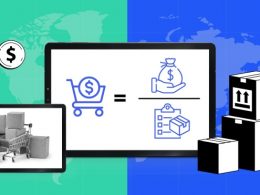The e-commerce space continues to evolve, offering businesses a multitude of platforms and payment options to enhance their online retail operations. Central to this landscape are Shopify and PayPal – two titans that play pivotal roles in enabling seamless e-commerce transactions. By understanding and effectively integrating these systems, businesses can unlock new potentials for growth, user engagement, and customer satisfaction.
In this article, we will review the integration of Shopify and PayPal and we will learn how to best manage online transactions using e-commerce software
A short introduction to Shopify and PayPal
Shopify and PayPal are two influential players in the e-commerce ecosystem. They each offer the customers and merchants a host of benefits. Let’s take a quick look at what they can provide.
Key features of Shopify
Shopify is a prominent e-commerce platform that empowers businesses and individuals to create and manage their own online stores. Shopify has experienced significant growth and is now utilized by merchants across the globe.
Providing a comprehensive set of tools, Shopify enables users to construct aesthetically appealing and user-friendly online storefronts. The platform includes a website builder with a host of customizable templates, making it possible for individuals without coding skills to create a professional online presence.
In addition to this, Shopify has an extensive suite of product management tools. Users can effortlessly add products, create product collections, manage stock levels, and set shipping options, among other features. These tools are designed to help merchants handle all aspects of their e-commerce operations effectively, making Shopify a popular choice for online retailers.
Key features of PayPal
PayPal is a global online payment system that operates as a payment processor for online vendors, auction sites, and many other commercial users. PayPal has significantly revolutionized the way payments are made for goods, services, and even donations.
Renowned for its ease of use and security, PayPal provides a method for people to transfer money digitally without the need for traditional paper methods such as checks or money orders. It essentially functions as a middleman between individual buyers and sellers, handling the transaction securely on both ends.
One of PayPal’s most attractive features is its ability to work seamlessly across international borders, making it an excellent option for businesses looking to attract international customers. It supports transactions in multiple currencies, allowing people from different countries to make purchases without worrying about currency conversion.
PayPal offers an array of services for different types of users. For individual consumers, it offers a simple way to pay for purchases and send money to friends and family. For businesses, PayPal provides tools for processing customer payments, tracking sales, and managing business finances.
Understanding Shopify PayPal connection
Shopify PayPal is a fusion of two innovative platforms designed to optimize the e-commerce experience. When used together, Shopify and PayPal create a streamlined shopping experience that is secure, fast, and highly convenient. This synergy allows customers to check out with just a few clicks, fostering an environment of instant gratification that modern consumers appreciate. Furthermore, it offers the comfort of a secure payment gateway, thereby increasing customer trust and brand credibility.
Making payments simple with Shopify and PayPal integration
The PayPal Shopify connection is more than just a means of accepting payments. It’s a gateway to a global network of hundreds of millions of active PayPal users. By offering PayPal as a payment method, you tap into a vast market of consumers who prefer using PayPal for online transactions.
Payment simplicity is crucial in e-commerce. Complex or time-consuming checkout processes often result in abandoned carts. Shopify PayPal integration eliminates such issues by providing a quick, easy-to-use, and reliable payment solution.
Through this integration, customers can choose PayPal as their preferred payment method during checkout. They’re then redirected to PayPal’s platform to finalize the transaction—eliminating the need for manual credit card input and simplifying the entire payment process.

Product listings and PayPal: Optimizing your Shopify store
Product listings are an essential part of your online store as they directly influence a customer’s buying decision. They provide the first impression of your products and serve as the primary source of information for customers to determine whether the product suits their needs. Integrating PayPal into your Shopify store can significantly enhance the experience surrounding your product listings by offering a smooth, secure, and efficient transaction process. Here are ways to optimize your Shopify store with product listings and PayPal integration.
Simplified checkout process
When a customer decides to purchase an item from your product listing, the last thing you want is a complicated checkout process. With PayPal integration, the checkout process on your Shopify store becomes a breeze. It allows customers to make purchases without having to input their credit card details manually every time, streamlining the checkout and boosting conversion rates.
Increased trust and security
Trust is a crucial element in e-commerce. When customers see that PayPal, a globally recognized and trusted brand, is available as a payment option, it increases their confidence in your store. This is particularly beneficial for new or lesser-known businesses looking to establish their credibility in the market.
International reach
If you’re planning to sell your products internationally, the Shopify PayPal integration is beneficial. PayPal is used and trusted worldwide, eliminating potential barriers to purchase for international customers.
Quick updates and easy management
PayPal integration with Shopify allows for quick updates to your product listings, especially when it comes to pricing and discounts. Any changes made in Shopify are automatically reflected in PayPal, making it easy to manage your store.
Abandoned cart recovery
A common challenge in e-commerce is dealing with abandoned carts. Shopify and PayPal help address this issue by offering a seamless, secure, and quick checkout process. With fewer steps to finalizing the purchase and the trust that PayPal provides, you’re likely to see a decrease in cart abandonment rates.
Mobile optimized
Many customers shop on their mobile devices, and a clunky payment process can lead to lost sales. Shopify PayPal integration ensures your product listings and payment process are mobile-optimized, providing a seamless shopping experience no matter what device customers are using.
PayPal integration with Shopify: Bottom line
Optimizing your Shopify store with PayPal integration enhances your product listings by streamlining the transaction process, instilling customer trust, and increasing the overall efficiency of managing your online store. It not only improves the customer’s shopping experience but also plays a significant role in boosting your Shopify store’s conversion rates and overall success.
Learn more and explore the topic of Shopify storefront design.
Shopify Payments vs PayPal: Choosing what’s best for your store
While the focus is on the synergy between Shopify and PayPal, it’s worth noting that Shopify offers its own built-in payment gateway—Shopify Payments.
Shopify Payments is a built-in payment gateway provided by Shopify, allowing merchants to directly accept credit card payments from customers. This eradicates the need for integration with external payment gateways and offers a streamlined, user-friendly experience.
One of the significant advantages of Shopify Payments is its simplified payment setup. As a Shopify merchant, there’s no need to establish a separate third-party payment provider or a merchant account. All transactions can be handled directly through your Shopify administration panel. Moreover, using Shopify Payments has financial benefits. Specifically, Shopify waives transaction fees for those using their own payment platform. This can lead to substantial savings, particularly for stores with a high volume of transactions. It’s a feature that makes Shopify Payments an attractive option for many merchants.
In terms of functionality, Shopify Payments is fully integrated with other Shopify features. This includes Shopify’s own hardware solutions for physical stores, offering a coherent and unified payment system across different sales channels. Shopify Payments also supports Shopify Pay, which provides an accelerated checkout experience. This feature allows returning customers to save their shipping and billing information, thereby speeding up future purchases and enhancing the overall shopping experience.
Shopify Payments is available only in select countries, which could be a limitation for global businesses. On the other hand, PayPal offers global coverage and a recognized brand that can enhance your online store’s credibility. While transaction fees may be higher, the assurance that comes with PayPal’s brand recognition and customer trust might be worth the cost for many businesses. The best choice ultimately depends on your business model, target audience, and geographical reach.
Learn more about a breakdown of seller PayPal fee rates with our guide.
Payment safety with PayPal and Shopify: Ensuring customer trust
In e-commerce, securing customer trust is as important as securing transactions. A key advantage of integrating PayPal into your Shopify store is the robust security that PayPal offers. With advanced fraud protection and 24/7 transaction monitoring, PayPal not only protects your business but also reassures customers about the safety of their purchases.
Beyond that, PayPal provides buyer protection—a feature that can significantly increase consumers’ trust in your brand. It demonstrates that their purchases are secure and that your business values their safety and satisfaction.
Meanwhile, Shopify also contributes to payment security with its compliance to Payment Card Industry Data Security Standards (PCI DSS). By integrating Shopify with PayPal, you are providing a doubly secure platform for your customers, significantly boosting their trust in your business.
Shopify payments made easy with PayPal: A step-by-step guide
Now that we’ve explored the benefits of Shopify PayPal integration, it’s time to dive into the actual setup. Integrating PayPal with your Shopify store is a straightforward process. It’s as simple as linking your PayPal Business account to Shopify and letting the two platforms synchronize. Here’s a straightforward step-by-step guide.
- Go to your Shopify admin page, click on “Settings,” and then select “Payment Providers.”
- In the PayPal section, choose “PayPal Express Checkout.”
- Enter the email address associated with your PayPal Business account, then click “Next.”
- Log into your PayPal account to confirm the integration.
Once these steps are completed, PayPal should now be available as a payment method on your Shopify store. Nevertheless, potential hitches such as currency compatibility issues, account verification problems, or checkout glitches may arise during integration. However, most of these issues can be resolved by troubleshooting guided by Shopify’s comprehensive help center or PayPal’s customer support.
What are the advantages of using Synder when integrating Shopify and PayPal
Synder is a financial management tool that simplifies the synchronization of transactions between your e-commerce platform (Shopify) and your payment gateway (PayPal). Here are several advantages of using Synder in Shopify PayPal integration.
Automated synchronization
Synder automatically syncs your sales, fees, refunds, and other transactions from Shopify and PayPal. This feature helps save time and reduces the likelihood of human error in manual data entry.
Multi-channel integration
If your business operates on multiple channels or platforms, Synder can handle all of them simultaneously (marketplaces, payment gateways, and POS systems). This provides you with a consolidated financial view, making managing your overall e-commerce operations easier.
Accurate reconciliation
Synder ensures that your books are always accurate and up-to-date by synchronizing transactions in real time. This enables better financial tracking and smoother auditing processes.
Tax compliance
Synder can calculate and categorize taxes on transactions accurately. This makes tax reporting and compliance much simpler, especially for businesses with international sales where different tax regulations apply.
Simplified financial reporting
With all your transaction data accurately synchronized and categorized, generating financial reports becomes easier. This allows for better business insights and data-driven decision-making.
Inventory management
Synder can help monitor your inventory levels across all platforms, providing up-to-date information about your stock levels, which can be crucial for effective sales and marketing planning.
How to set up Shopify PayPal integration using Synder
Setting up Shopify and PayPal integration using Synder, an online tool that helps with financial data synchronization, is a straightforward process. Here is a step-by-step guide on how to do it:
- Create a Synder Account: If you don’t already have an account, go to the Synder website and sign up.
- Integrate Synder with Shopify: Once you’re logged into your Synder account, navigate to the “Online Stores” tab on the left side menu and click “Add online store”. Then select Shopify from the list and provide your Shopify store URL. Click on “Connect” and grant all necessary permissions for Synder to access your Shopify data.
- Integrate Synder with PayPal: Navigate to the “Payment platforms” tab and click “Add payment platform”. Select PayPal from the list and follow the prompts to connect your PayPal account. Grant necessary permissions to let Synder access your PayPal data.
- Configure Settings: Now, both your Shopify and PayPal accounts are connected to Synder. Go to the “Settings” tab and ensure everything is set up according to your needs. Here, you can set up how your sales, fees, taxes, and discounts will be synchronized from both Shopify and PayPal.
- Start Syncing: Once your settings are configured, navigate to the “Online Stores” or “Payment platforms” tab and click “Sync now”. Synder will start importing and syncing transactions from both your Shopify and PayPal accounts.
- Review Transactions: After the syncing is complete, review your transactions within the Synder dashboard to make sure everything has been imported correctly.
PayPal and Shopify integration: Conclusion
In the ever-evolving e-commerce landscape, the integration of Shopify and PayPal proves to be a game-changer for businesses, transforming the transaction process to become simpler and more secure. Leveraging this integration optimizes the overall online store performance, enhancing customer trust and providing a streamlined shopping experience that meets the needs of modern consumers.
With the addition of financial management tools like Synder, businesses can further amplify the benefits of Shopify PayPal integration. Synder’s capabilities to automatically synchronize sales data, manage multi-channel operations, ensure tax compliance, and facilitate accurate financial reporting bring an extra layer of efficiency and precision to your e-commerce operations.
As businesses strive to cater to the rapidly changing needs of consumers, platforms like Shopify, PayPal, and Synder play a vital role in shaping a dynamic, secure, and user-friendly online retail space. The future of e-commerce holds exciting prospects, and it will be fascinating to observe how these platforms adapt and continue to revolutionize the industry.







.png)
